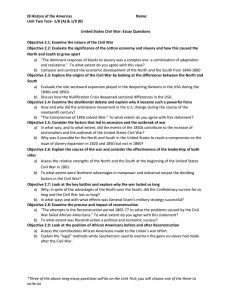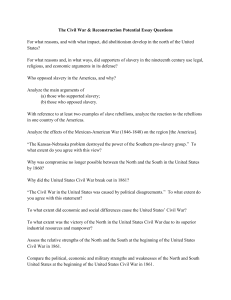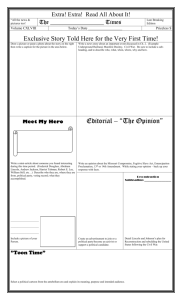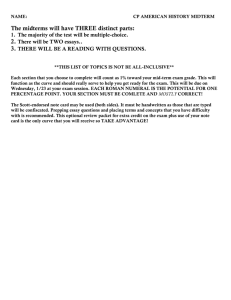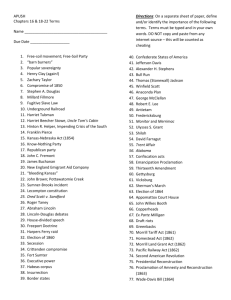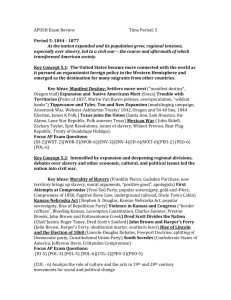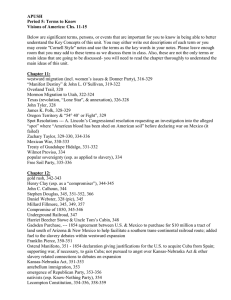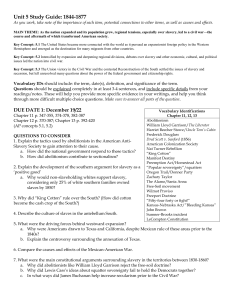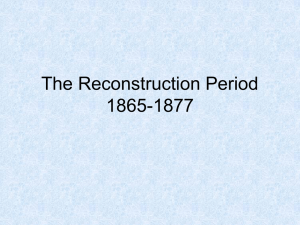The Civil War and Reconstruction
advertisement
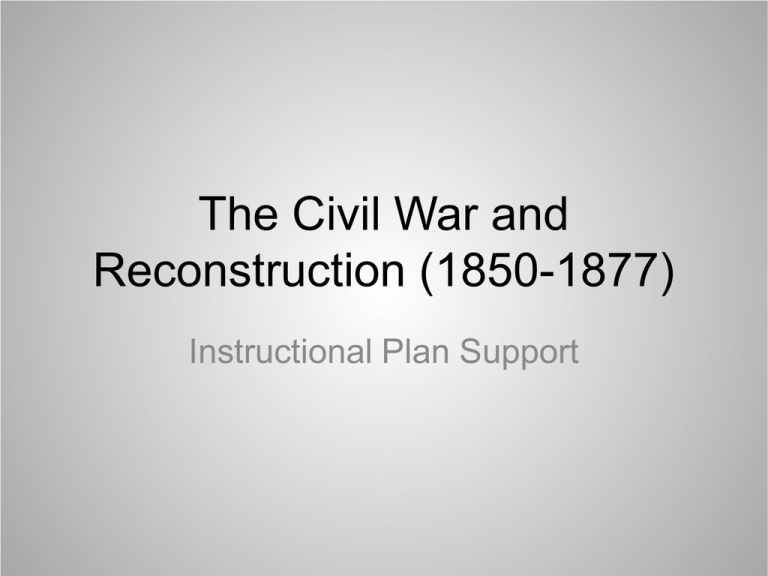
The Civil War and Reconstruction (1850-1877) Instructional Plan Support Standards for Grades 5-12 • (1) Students will understand how the North and South differed and how their economic systems, politics, and ideologies led to the war. • (2) Students will understand how the resources of the Union and Confederacy affected the course of the war. – Students will understand the social experience of the war both on the battlefield and homefront. • (3) Students will understand the political controversies over Reconstruction, and how programs were designed to transform social relations in the South. – Students will then evaluate the successes and failures of Reconstruction in the South, North, and West Big Idea Essential Question • To what extent did the Civil War fundamentally change the United States? Possible Essential Questions • How central was slavery to the conflict? • How did the North and South’s differences in economic systems, politics, and ideologies lead to the Civil War? • How did the resources of each side affect the course of the war? • How were people’s lives affected by the conflict? • What cultural practices, including art and photography, did Americans draw upon for conceptualizing westward expansion, conflict with Indians, and Civil War? Possible Essential Questions (cont) • What was the political controversy over Reconstruction? • How did Reconstruction programs transform social relations in the South? • What were the successes and failures of Reconstruction? • How did westward expansion, Indian removal, the Mexican-American War, and insurgent women’s voices challenge and change those institutions? Possible Lesson Topics • The South and the Institution of Slavery • Compare and contrast the North, South, and West • The Compromise of 1850 and the Dred Scott Decision • “Free labor” ideology and its impact on slavery • Secession: order of and reasons for • Compare and Contrast resources and technology • How individuals influenced the course of the war Possible Lesson Topics (cont) • Why people fought, or resisted fighting, and the reason(s) for the sides they took • How important were the “Gettysburg Address” and the “Emancipation Proclamation” to the war effort? • The costs of war and its successes • The Reconstruction policies of Lincoln, Johnson, and Congress Possible Lesson Topics (cont) • Johnson’s impeachment trial • The 14th and 15th Amendments • The role(s) and position(s) Native Americans took both during the conflict and reconstruction • The programs, political influence, social position, and progress made by blacks after the conflict • The influence of the Industrial Revolution on the Civil War and Reconstruction Guided Discovery Activities • Research papers, projects, and presentations • Timelines • Posters (Glogster) • Primary Source Analysis • Artifact Analysis • Newspapers • Reader’s Theater • Balance Sheet • Found Poems • • • • • • • • • • Social Media Mock Trials Debates Maps Podcasts Re-enactments Journaling “Quilt” Simulation Supreme Court Case Studies Biography (brief list) • • • • • • • • • • • • • • • Susan B. Anthony Clara Barton Belle Boyd John Bozeman John Brown Blanche Bruce George A. Custer James Buchanan Chief Joseph Bill Cody Jim Crow Jefferson Davis Frederick Douglass Robert Elliot Exodusters • • • • • • • • • • • • • • • Charlotte Forten William Lloyd Garrison Ulysses S. Grant Rose Greenhow Thomas “Stonewall” Jackson Andrew Johnson Robert E. Lee Abraham Lincoln Thomas Nast Red Cloud Hiram Revels William Tecuseh Sherman Elizabeth Cady Stanton Harriet Beecher Stowe Harriet Tubman Documents • 13th, 14th, and 15th Amendments • 1820 Missouri Compromise • Compromise of 1850 • Compromise of 1877 • Wilmot Proviso • Kansas-Nebraska Act • Dred Scott v. Sanford (1857) • Lincoln-Douglas Debates • Party platforms during the 1860 • Lincoln’s First Inaugural Address • Mississippi Resolutions (1860) • South Carolina Declaration of Causes (1860) • Diaries and Letters of Union and Confederate Soldiers • Emancipation Proclamation • Gettysburg Address • Freedmen’s Bureau • Black Codes • Ku Klux Klan Assessing for Understanding • To what extent did the Civil War fundamentally change the United States? – Slavery ends – Loss of 360,000 Union and 260,000 Confederate troops (almost more than all other wars combined) – Shift in power to Northern Industry and away from Southern Planter Class – Strengthened Power of Federal Government (raised tariff, enacted income tax, imposed new taxes, system of federally chartered banks) – Defined Citizenship – Left unaddressed was the adjustment of American society to end of slavery: KKK & Black Codes-14th & 15th Amendment-Jim Crow – Expansion and consolidation of the American West • Homestead Act and the Railroads – Removal of Native Americans
